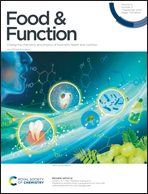Selenium-enriched peptides identified from selenium-enriched soybean protein hydrolysate: protective effects against heat damage in Caco-2 cells†
Abstract
Our previous study evaluated the antioxidant and anti-inflammatory activities of selenium-enriched soybean peptides (SePPs) in vivo. In this study, we purified SePPs via gel filtration chromatography and obtained five fractions (F1, F2, F3, F4 and F5), among which F3 displayed the highest antioxidant and anti-inflammatory activities. Nineteen selenium-enriched peptides were identified in F3 by mass spectrometry. Two selenium-enriched peptides with sequences ESeCQIQKL (Sep-1) and SELRSPKSeC (Sep-2) were selected for synthesis based on their score and the number of hydrophobic amino acids, acidic and basic amino acids. Both Sep-1 and Sep-2 exhibited preventive effects on the heat stress-induced impairment of intestinal epithelial cell integrity, oxidative stress and inflammatory responses in a Caco-2 cell model. Pretreatment of the cells with Sep-1 or Sep-2 for 24 h reduced intracellular reactive oxygen species (ROS) generation, prevented the disruption of tight junction (TJ) proteins, and decreased paracellular permeability. Western blot results showed that Sep-1 and Sep-2 could improve the abnormal expressions of Nrf2, Keap1, NLRP3, caspase-1 and ASC/TMS1, thereby enhancing the glutathione (GSH) redox system and reducing IL-1β and IL-18 concentrations. Sep-1 activated the Nrf2-Keap1 signaling pathway significantly more than Sep-2. Molecular docking results indicated that Sep-1 and Sep-2 are both bound to Keap1 and NLRP3 in the form of hydrogen bonds, hydrophobic interactions and salt bridges, which interferes with Nrf2 and NLRP3 signaling. Molecular dynamics simulations suggested that more hydrogen bonds were formed during the resultant process of Sep-1 with Keap1, and the compactness and stability of the complex structure were better than those of Sep-2. These findings confirm the value of both Sep-1 and Sep-2 in the development of dietary supplements as potential alternatives for heat damage and related disease prevention.

- This article is part of the themed collection: Food & Function HOT Articles 2023


 Please wait while we load your content...
Please wait while we load your content...